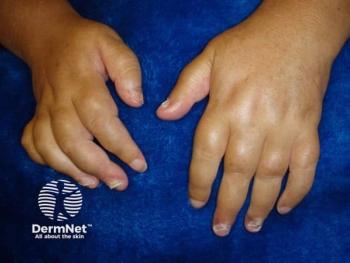
Overview of Generalized Pustular Psoriasis (GPP)
Aaron S. Farberg, MD, and Jeffrey Crowley, MD, provide an overview of generalized pustular psoriasis, identifying flares, the burden on patients, and available treatment options.
Episodes in this series

Aaron S. Farberg, MD: Hello, everyone. Welcome to today’s episode of Dermatology Live® Between the Lines. Today’s featured article is “Understanding Flares in Patients with Generalized Pustular Psoriasis Documented in US Electronic Health Records.” My name is Aaron Farberg. I’m a board-certified dermatologist and Mohs surgeon in private practice in Dallas, Texas, and I’m affiliated with Baylor Scott & White Health. Joining me is my colleague Dr Jeffrey Crowley, a dermatologist at Bakersfield Dermatology & Skin Cancer Medical Group in Bakersfield, California. Dr Crowley leads an active clinical trial center in Bakersfield, California, so I’m excited to have his insights.
In today’s discussion, we’ll review the featured article surrounding generalized pustular psoriasis [GPP] and explore the differences in the management and treatment of patients with GPP experiencing disease flares and those without. We have a number of fun and exciting questions that Dr Crowley and I will be discussing. First, welcome Dr Crowley. I’m happy to have you. The first question I want to discuss is a brief overview of generalized pustular psoriasis. Give me the 2-minute overview. What’s the pathophysiology of GPP? How is it different from plaque psoriasis? Then we’ll get into some of the challenges.
Jeffrey Crowley, MD: It’s great to discuss this topic. This is something I’ve been working on for several years. First, GPP is a fairly rare condition, especially in the United States. It’s a little more common in some Asian countries. It’s a systemic disease that often includes systemic symptoms such as fever, chills, and fatigue, and patients have sterile pustules on a background of erythema. It can be eruptive. This can occur quickly. Patients start with a few areas of involvement, and it can become quite generalized. It can exist in a patient with psoriasis, but it can also exist de novo, with no antecedent psoriasis. There are a lot of challenges in identifying this disease. It’s often seen in the emergency department or at urgent care centers and not in dermatology offices because it can present so acutely.
Aaron S. Farberg, MD: That’s a great description and a great background of GPP. Even though it has psoriasis in the name and you can have both, the pathophysiology of it is unique. We all think of plaque psoriasis. We know the IL-17 pathway and IL-23 and how they work. With GPP, it can be very different. It goes through the IL-36 pathway thanks to all the research that’s been ongoing to delineate these 2 very different diseases. They’re different clinically as well, as Dr Crowley mentioned. Patients with GPP are often sick, and we need to intervene urgently. What are some of the challenges in identifying GPP? You hit it on the nose: identifying neutrophilic pustules that can be quite eruptive. What are GPP flares, and how are they evaluated in clinical practice? What are you doing to evaluate these GPP flares?
Jeffrey Crowley, MD: The flares are difficult because the first time the patient has a flare—the first time they present with disease—they probably don’t have a diagnosis. There’s quite a delay in diagnosis for many patients. Some patients go years without getting a diagnosis of generalized pustular psoriasis. The first thing is seeing the right person to make the diagnosis. We like to think that’s the dermatologist. That’s the first thing.
Once a patient has GPP and you’ve controlled the flare, they can have subsequent flares. There could be a lot of trigger factors for these subsequent flares. The disease is treated in 2 ways. One is treating the flare and the other is treating the underlying inflammatory symptoms to prevent the next flare. They’re 2 different approaches. The flare is driven by neutrophils. The neutrophils are going haywire. They’re being recruited into the skin and causing this rapid progression of pustular disease, so we have to shut that down. Until recently, we haven’t had a drug targeted for that. We used things that are more generalized anti-inflammatory, things like cyclosporin, methotrexate, retinoids, and biologics, which treat psoriasis but aren’t going after what we’re dealing with the actual pustular flare.
We have to calm the patient down. If you look, a number of things that have been used to calm the patient down. It’s a litany of things. Once the patient has calmed down, it’s nice to have something controlling that background inflammation so they don’t have a subsequent flare.
Aaron S. Farberg, MD: I agree. I used to say, “Treat them by throwing the kitchen sink at them.” We use every treatment we can, and whichever 1 works is the 1 we use last. That’s a very good perspective on how we can approach these patients clinically, seeing them in the acute phase, and then how we’re going to manage them chronically. Speaking of which, can you discuss the burden of GPP that you’ve seen in your patients or their quality of life?
Jeffrey Crowley, MD: Having a rare disease is stress in and of itself. The stress of getting a diagnosis and then wondering, “Why me? What’s going on here?” And there’s really no standard treatment. You’re told you have a rare disease, but we don’t know exactly why you have this. There are obviously some genetic loci that can affect a patient’s risk of having the disease, but in general, we don’t know that. Patients who have this flare have a lot of pain. They have pain, they’re sick, and they feel awful. This can affect other aspects. This can put them into heart failure. They can have fluid overload. They can get sick and be hospitalized. This is a disease that has a mortality risk associated with the disease itself. It’s not high, but it exists. For most of our skin diseases, we don’t have direct mortality acutely associated with the disease.
Those are all things that can impact the patient’s quality of life. They feel bad, they have pain, and there could be uncertainty about their treatment and the path that they’re going to have. Once this acute flare is under control, their big fear is when is it going to flare up again?
Aaron S. Farberg, MD: You’re absolutely right. The burden is large, and it’s incredibly significant for our patients. We’re talking about mortality. With dermatologic diseases, we’re often not as concerned about living or dying. But with this disease, it’s at the top of our concerns. There are so many issues these patients go through. One thing you said is that we’re limited in the number of treatments we have that are even approved for a disease like GPP, or generalized pustular psoriasis. What treatment options are available? Is there any hope? What do we have down the line? More important, has anything been approved recently? What can we do to help these patients?
Jeffrey Crowley, MD: What a great and timely question. Until recently, we didn’t have a single agent approved for treating generalized pustular psoriasis in the United States. Some drugs have been approved based on anecdotal evidence in other countries, but not in the United States. An IL-36 receptor antagonist was recently approved. This drug affects IL-36 metabolism, which is important for the process that’s going on with the neutrophil activation. IL-36 is critical for a lot of the chemokines that pull neutrophils into the skin. It turns off that postulation, and their trial showed that vs placebo, it turns the pustules off. The primary end point for the study was 7 days after a single IV dose. It’s an IV infusion. That drug is available, and it’s specifically available to treat pustular flares. It hasn’t been approved to treat pustular psoriasis ongoing. It’s for flares at this point, but it gives us something to use for our patients who are hot and flaring. It’s something specific to use for our patients who have a flare.
Transcript edited for clarity
Newsletter
Like what you’re reading? Subscribe to Dermatology Times for weekly updates on therapies, innovations, and real-world practice tips.





















